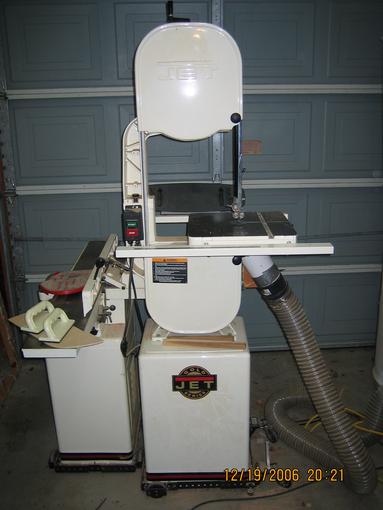I generally leave a Lenox, 1/2", 4 tpi, bi-metal blade on my saw at all times.

The Timberwolf Myth
When I started, I tried to follow the collective internet wisdom, so I went out and bought several different kinds of Timberwolf blades. After trial and error, I learned three important lessons.
First, this idea of setting the blade tension using the “flutter method” is bogus. It takes forever and at least once the blade never fluttered and I let off so much tension that the blade came off the wheels and was instantly ruined. Now I have an Iturra replacement spring and I just set the tension to the marks on the saw. That works fine.
Second, despite the “induction hardened” teeth, the Timberwolf blades dulled at about the same rate as any carbon steel blade that I’ve tried – quickly. As the blade dulls, the drift changes, meaning you have to adjust the fence to keep to saw cutting straight. That is way too much trouble, especially if the bandsaw is the primary saw in your shop.
Third, sawing can generate a lot of heat on the blade, which can cause it to lose its temper and be instantly ruined. This is particularly true of resawing.
Don’t believe the silicone steel hype. They perform the same as regular carbon steel blades, which you can get from Lenox for less money.
Carbon steel blades are good for occasional use, but for roughly twice the price, you can get a bi-metal blade, which solves the problems of the blade going dull. Bi-metal blades have much harder teeth and can take much more heat. I have never ruined a bi-metal blade from pushing it too hard. I have heard that they last about 10 times longer than a carbon steel blade, which sounds about right.
The Blade Changing Myth
When I started out, I would constantly switch blades, trying to match the number of teeth to the thickness of material. That took forever. At some point I got lazy and stopped switching the blade and you know what? My 4 tpi blade did fine on everything from 1/4" plywood to 10" resaws.
However, I still felt like the finer tooth blades gave a smoother finish, so when I cut dovetails on my bandsaw, I would switch blades. Then I read an article by Michael Fortune in Fine Woodworking #173 in which he said to use a 3 tpi blade for everything. After I read that article, I didn’t switch out my 4 tpi blade to cut dovetails and it worked fine. Keep it simple.
Of course the one exception to all of this is cutting curves. If you have to cut tight curves, then a more narrow blade is in order.
Other Bi-Metal Blades
As I said at the beginning, I use a Lenox, 1/2" 4 tpi blade. After reading the Michael Fortune article mentioned above, I tried to find a 3 tpi bi-metal blade. I finally found one by Olson, so I tried one of their “MVP” blades. I was excited when I got the box. Made in the USA! Amazing! When I tried it on my saw, my was severely disappointed.
Brand new, the blade drifted excessively. To cut a straight line, I had to turn the board about 15 degrees. I couldn’t adjust the fence on my saw for that much drift. The blade cut quickly, so I wanted to make it work. I modified the fence to allow for for drift, and that still wasn’t enough. I checked everything on the saw: wheels were coplanar, blade was positioned well on the wheels, guides were adjusted. Nothing helped. I think the problem may have been that my saw couldn’t generate enough tension on the blade. Anyway, I put the old faithful Lenox blade back on and the saw cut straight as an arrow.
